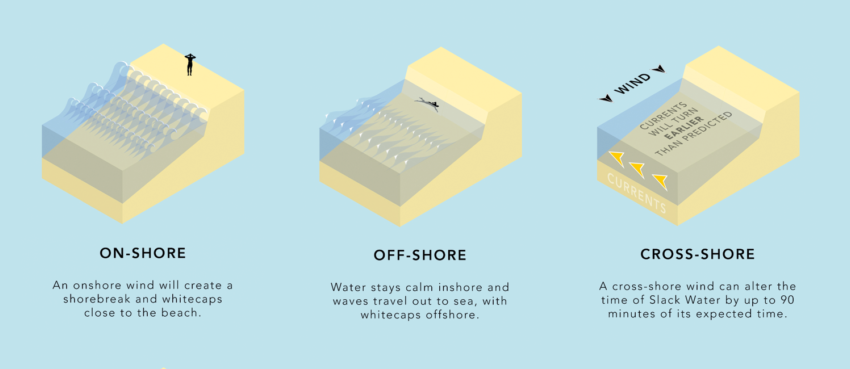How wind shapes the sea
William Thomson, author of Wild Tides, talks us through how wind shapes the sea
So far in this series we have learnt what to expect from different phases of the tide, and the currents it creates. Now we will move away from the hydrosphere and explore the atmosphere, because the two are inextricably linked.
Starting with the theory, what actually makes wind? Wind is the movement of air from areas of high pressure [where cold air is sinking] to areas of low pressure [where warm air is rising]. The wind this process creates has a massive effect on the seas in which we swim, and the two variables you need to consider are speed and direction. While stronger winds definitely have the potential to create rougher seas, in coastal waters the direction it blows is perhaps even more significant. Cross-shore, on-shore or off-shore winds shape very different seas.
On a day with no incoming swell and a strong offshore wind, the likely effect is whitecaps out at sea, but calm water that’s perfect for swimming close to shore. This is because wind needs to blow over a large area of water to make waves, a phenomenon called fetch. Close inshore, where the wind has come straight off the beach, there has been no fetch so there are no waves – but as you go further out the ripples will grow into waves, which is why you will see whitecaps out at sea. Following this theory, if you were to spin the wind around so that it blows onshore, the whitecaps would come all the way to the shore and a heavy shorebreak would start crashing on the beach, despite the wind speed staying the same. This emphasises how wind direction is sometimes more important than speed. If you have the luxury of being on a narrow stretch of coast, like Cornwall, you can make the most of this effect by swimming on the downwind side, or the leeward coast as sailors would call it.

If it’s not possible to find a leeward coast, one option is to time your swims for when there is a higher probability of offshore winds. At night, the land cools quicker than the sea, so wind blows from the colder land to warmer sea; this offshore breeze is common in the early morning. But by mid-morning [especially if it’s sunny] the land heats up faster than the sea, and the temperature difference forces the wind onshore. If there’s a swell [which we will learn about in more detail next month] this cycle plays a significant role in how the waves break. Offshore winds create tidy waves that peel mechanically, holding their shape for longer. In contrast, onshore winds create the opposite; messy waves that break all over the place. This is another reason why offshore winds are preferable, because they make reading the waves simpler and the clean faces are fantastic for bodysurfing.
If you’re on Britain’s East Coast in the spring and summer, there’s one more reason to avoid onshore winds; they create Sea Fog. Known as a Haar in Scotland and Sea Fret in Northumberland, Sea Fog forms when warm air blows over a cold sea, cooling the water vapour to its dew point so that it condenses into water droplets. The reason it’s so common on the East Coast from March to September is because the waters in the central North Sea are 1-2 degrees warmer than the coastal waters, so an onshore wind brings the warm air over the cold sea, where it turns into fog. I can vouch for the cold; last summer I had to revert to breaststroke on a swim in Northumberland because of brain-freeze while front crawling. Luckily, there was an offshore breeze otherwise it would have been prime conditions for the Fret to add to my woes.
For a Sea Fog to disperse you need a change of wind direction; ideally an offshore breeze, but a cross-shore will work. However, this presents new challenges. Last month I demonstrated how a cross-shore wind creates choppy seas if the wind and tidal currents oppose each other, and flat seas if they are travelling the same way. Another consequence of a cross-shore wind is its effect on the time of slack water. When I was filming How to Spot Currents for the Tidal Compass YouTube, there was a 15-knot northerly wind and the currents were supposed flowing to the north. One of the demonstrations was for my partner Naomi to go for a swim and drift with the currents; it was an hour and a half before Slack Water do they should have been flowing to the north. But instead she drifted south. The strength of wind had obviously overpowered the currents and Slack Water had arrived 90 minutes early – a reminder that tides do not move with a mechanical precision, but a fluid motion that is strongly affected by the wind. This also affects the vertical tide; an onshore wind will push water up the beach and give higher tides, while offshore winds will push back the water, creating lower tides.







